
Text by MARTIN WINDROW, Color plates by MICHAEL ROFFE. YEAR 1972
THE PANZER DIVISIONS
The German Army's elite formation, at all stages of its history. It evolved originally from the Berlin Watch Regiment, and by 1940 was designated Infanterie Regt. (Mot.) 'Grossdeutschland'; it fought in France under the command of General Graf Schwerin. In 1941 it saw action in the Balkans and Greece, and as part of Guderian's 2nd Panzer Army during the first year in Russia. By early spring 1942 the unit had expanded to divisional strength. As happened in other cases of units with better-than-average establishments, the official re-designations tended to lag behind the facts; thus the 'GD' slowly became a Panzergrenadier unit, and then a Panzer formation, although its armoured strength was as good as, or better than, actual Panzer divisions for months or years beforehand.
Continuously engaged in the southern and central zones of the Russian front throughout 1942, the division took part in the recapture of Kharkov in March 1943 alongside the premier Waffen-SS Panzer formations. It fought in the great offensive around the Kursk salient in July 1943, and in the gruelling withdrawals from the Donets and the Dnepr Bend in the winter of 1943/4. In May of 1944 the division was heavily committed in Bessarabia, and in July was back in the central part of the front, countering the Soviet summer offensive. In the period August- October 1944 'GD' fought in Kurland, and mounted a stubborn defence around the Memel bridgehead in November. It suffered terrible casualties, and a part of its strength was encircled at Memel. Those units which escaped were reformed in East Prussia; between January and March 1945 the remnants of 'GD' fought a series of defensive actions around the Frisches Haff, from which few escaped.
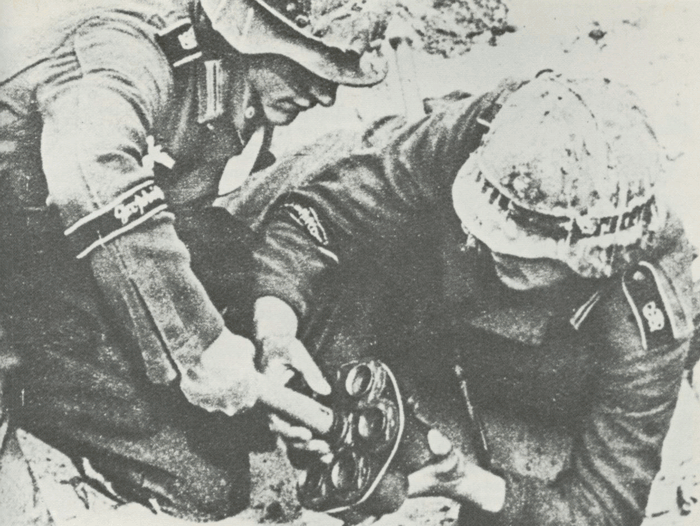
Panzergrenadiers prepare a powerful charge by wiring the heads of seven stick-grenades round one complete grenade. They wear the cuff-titles and shoulder-strap monograms of the crack 'Grossdeutschland' Division, the Army's most powerful armoured formation. (Imperial War Museum)
Panzer Regt. 'Grossdeutschland' (I Bn., PzKpfw. V Panther tanks; II Bn., PzKpfw. IV tanks; III Bn., PzKpfw. VI Tiger tanks)
Panzergrenadier Regt. 'Grossdeutschland' (I Bn., armoured; II and III Bns. motorized; strong integral anti-tank, anti-aircraft and S.P. artillery units)
Füsilier Regt. 'Grossdeutschland' (I Bn., armoured; II and III Bns. motorized; strong integral A-T, A-A and S.P. artillery units)
Panzer Aufklärungs Abteilung 'Grossdeutschland' (1 Sqn., Jagdpanzer 38t.; 2 and 3 Sqns. armoured half-tracks; 4 Sqn., towed artillery)
Panzer Artillerie Regt. 'Grossdeutschland' (I Bn., S.P. guns; II, III and IV Bns., half-track-towed guns)
Panzer Sturmgeschütz Brigade 'Grossdeutschland' (1, 2, 3, 4 Batteries armoured S.P. assault guns)
In the latter part of the war various other elite units, expanded and equipped for realistic participation on the battlefield, were grouped under the overall control of the Division 'GD' with the collective title 'Grossdeutschland Verbände' These included various armoured formations:
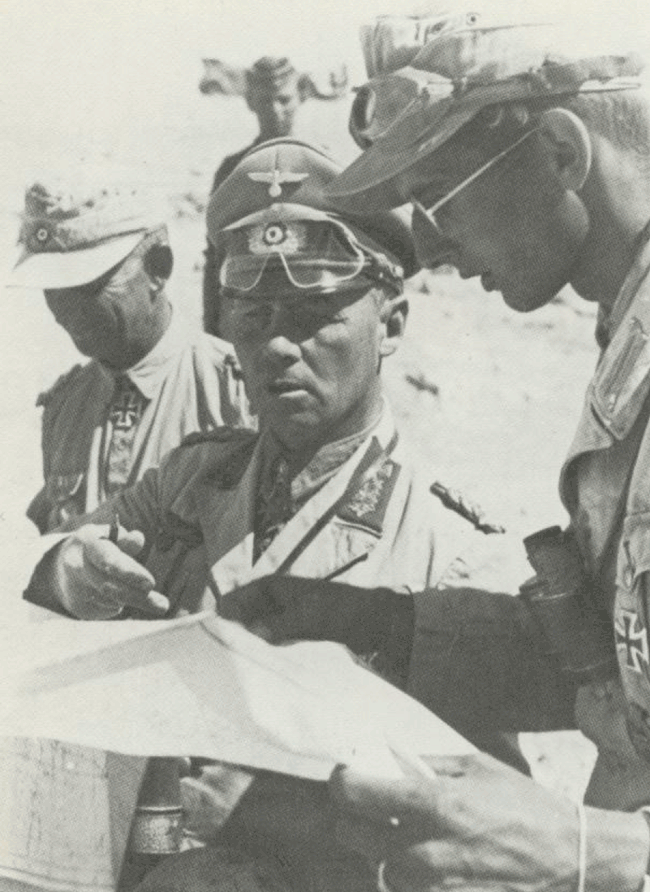
Rommel, a legend in his own lifetime; with limited forces and a crippling supply problem, he outguessed and outfought the Allies in Africa for two years. His brand of dashing 'cavalry' generalship was well suited to desert warfare. (Imperial War Museum)
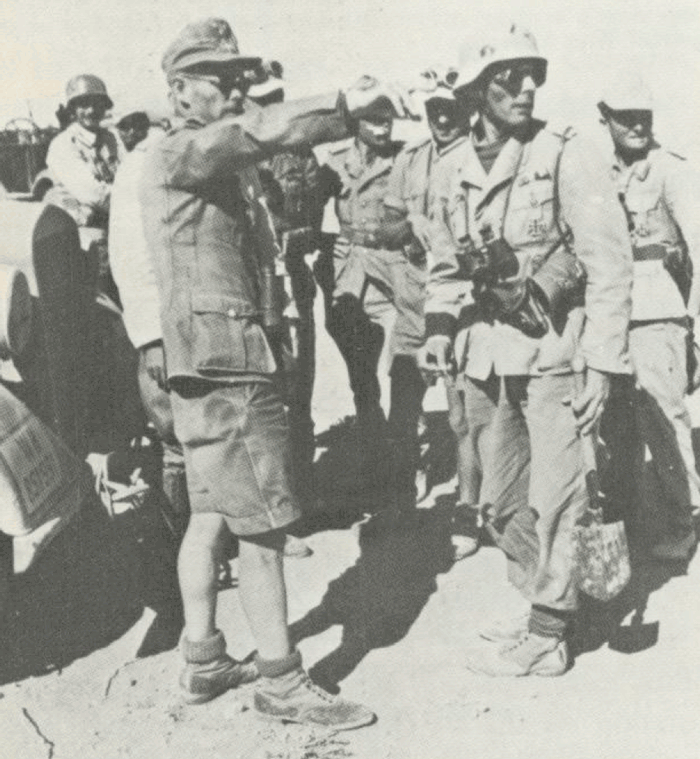
The motley clothing of the desert soldiers, Allied and Axis alike, exemplified by a group of Panzergrenadiers. (Imperial War Museum)
Originally formed in late 1939 as the Führer-Begleit-Bataillon, this unit was the motorized escort for the Führer's general headquarters. In 1940 they were awarded a 'Grossdeutschland' cuff-title. During 1940 they were used for various internal escort and V.I.P. security duties; the unit was fully motorized and heavily armed, acquiring a Panzer company at an early date. Though only infrequently used in combat throughout most of the war (there were two brief excursions to the northern sector of the Russian front) the unit was kept up to scratch by constant and punishing training; they were usually based at Hitler's Rastenburg headquarters. Part of the battalion was moved to Berchtesgaden in 1944; and in July the unit was brought up to regimental strength. In November 1944 the unit, in brigade strength, was sent to the Western front and was very heavily engaged during the Ardennes offensive. Subsequently, in January 1945, it was upgraded to divisional establishment and sent to the Oder front with its sister unit, the Führer-Grenadier-Division (q.v.). Heavily engaged in defensive operations, the F-B-D was decimated while breaking out of a Soviet encirclement near Spremberg in April 1945.
Main combat units: Panzergrenadier Regt. 'Führer-Begleit-Brigade' Panzer Regt. 'Führer-Begleit-Brigade' Artillerie Abteilung 'Führer-Begleit-Brigade', Infanterie Bn. 'for Special Duty' 828.
Raised after the attempt on Hitler's life in July 1944, the Führer-Grenadier-Brigade was stationed at Cottbus near the Rastenburg 'Wolf's Lair'. At the end of September, consisting of a Panzergrenadier Battalion, a Fusilier Battalion, and a Panzer Abteilung, it was moved to the East Prussia area. Between October and December 1944 it was continuously and heavily engaged against Soviet thrusts; in that month it was sent west to the Ardennes. In February it went east again, to the Stargard area, and was engaged in further heavy fighting; it had been uprated to divisional strength at the same time as its sister unit. In March it was at Stettin, and later fought around the Küstrin bridgehead. In April the unit was sent to Vienna; it eventually surrendered to U.S. forces in Austria but was handed over to the Russians. Personnel wore 'Grossdeutschland' insignia throughout the unit's career.
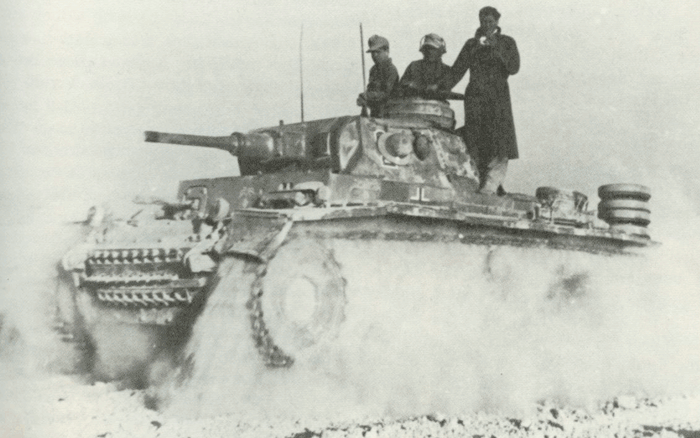
A PzKpfw. III of the Afrika Korps (the palm and swastika badge is just visible on the frontal armour by the driver's vision slot) churns up the dust of the Western Desert. (Imperial War Museum)
Main combat units: Panzergrenadier Regt. 'Führer-Grenadier-Brigade' (comprising an armoured fusilier battalion and a motorized Grenadier battalion), Infanterie Bn. 'for Special Duty' 829, Panzer Regt. 'Führer-Grenadier-Brigade', Sturmgeschutz Brigade 'Führer-Grenadier-Brigade'.
Formed at Cottbus in late January 1945, and with personnel bearing 'GD' insignia, this unit fought on the Oder front between February and April. It managed to withdraw in late April and the remnants surrendered to U.S. forces in May. It consisted of a Panzer Regiment, a Panzergrenadier Regiment, a Panzer Artillerie Regiment and the usual divisional reconnaissance, engineer and signals units, all identified by the honour title 'Kurmark'.
Several armoured formations, many of them without practical significance, were formed on paper in the closing months of the war. This period was characterized by decrees from Hitler's headquarters regarding the formation and movements of units whose only existence was in the form of flags on the Führer's maps. Among these twilight formations were the following:
Panzer Division 'Feldherrnhalle 2'. Formed at the turn of 1944/5 from the surviving elements of the 13. Panzer Division and the 60. Panzergrenadier Division 'Feldherrnhalle', both of which were decimated in the defence of Budapest. Much under strength, the division fought in Hungary and Austria until the end of the war.
Panzer Division 'Kurland'. Formed within the encircled German armies in the Kurland area, from elements of the 14. Panzer Division and other motorized 'odds and ends'.
The personnel of various schools, training courses, reserve organizations, and so forth, were to be formed into Panzer divisions named 'Clausewitz', 'Holstein', 'Münchenberg', 'Donau', 'Schlesien', 'Thüringen', and 'Westfalen'; how far these plans proceeded in practice is not known.
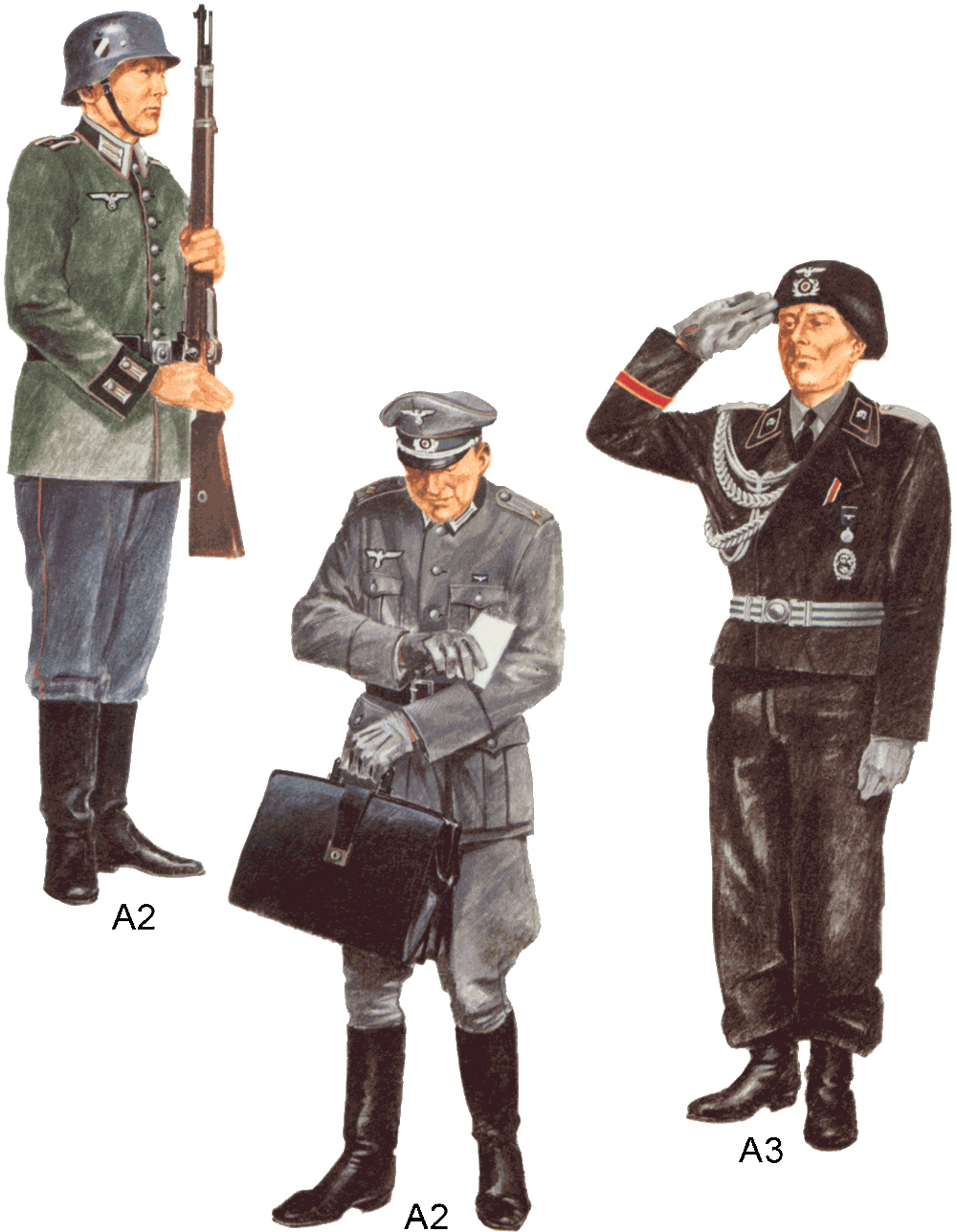
A1 Unteroffizier, Panzer truppen, parade dress
This sergeant is presenting arms; he carries the normal Mauser K.98 rifle of 7-92 mm calibre, and six black leather ammunition pouches are slung on his black leather service belt. The rectangular belt-plate, in bright metal, bears an eagle and swastika within a wreath charged with the words Gott Mit Uns - 'God With Us'. His 1935-model steel helmet is painted dark grey, with a black/white/red tricolour decal on the right side. The black leather hobnailed Marschstiefel - marching boots - are standard issue.
The special full-dress tunic, worn for parade, walking out, and other ceremonial occasions, was known as the Waffenrock. It is of field-grey cloth, without external pockets, and the turn-down collar and deep Swedish cuffs are of dark blue-green 'badge cloth'; the shoulder-straps are also made of this material. Introduced in June 1935, it has a much more ornate appearance than the usual service tunic; it is worn with plain grey trousers - giving a contrasting appearance - piped down the outer seam in Waffenfarbe. This is the identifying colour of the branch of service within the Army; in this case, the rose-pink of the Panzertruppen. It appears in several places on the tunic - as piping up the front join, around the bottom and front edges of the collar and around the top and rear edges of the cuffs. The silver collar-bars are woven on patches of this colour, as are the decorative cuff tabs. The 9mm-wide Tresse or silver braid around the top and front of the collar, and the top and rear of the cuffs, is an indication of senior N.C.O. rank. It also appears on the shoulder-straps, within an outer piping of pink. On the shoulder-straps the open-ended silver braid identifies the exact rank, and the numeral the regiment.
The buttons on the front, cuffs and shoulders of the tunic are silver-grey metal. The breast eagle is woven in white on a black background, the appropriate style for the Panzer arm. The only equipment worn on the belt in this uniform order would be the bayonet.
A2 Oberleutnant, Panzertruppen, service dress
The normal everyday working dress of the German Army officer. The high-fronted peaked service cap, or Schirmmütze, is of field-grey cloth with a dark blue-green band and a glossy black composition peak. The two silver cap cords identify commissioned rank. The crown seam, and the top and bottom of the band, are piped in pink Waffenfarbe, The upper badge is a silver-grey alloy eagle, the lower one a wreath of oak leaves surrounding the national cockade; the wreath was sometimes woven in silver thread, more often pressed in silver-grey alloy.
The tunic is field-grey, with a dark blue-green badge cloth collar, four box-pleated pockets with scalloped flaps, and deep turn-back cuffs (often used, as here, as a handy extra pocket for small items). The shoulder-straps are in silver 'Russia braid' with the single yellow metal pip of Oberleutnant's rank and an underlay of Panzer pink Waffenfarbe. The silver collar-bars are woven on dark blue-green patches sewn to the collar. The breast-eagle is in silver thread on a black background. The Army Four-Year Service Medal ribbon, cornflower blue with a small applied silver eagle, is worn above the left breast-pocket.
The pegged breeches, worn by officers of all branches, are field-grey. The leather service belt with plain double-claw buckle, the black top- boots and grey kid gloves are all items common to the uniforms of officers in the Army, Luftwaffe and SS.
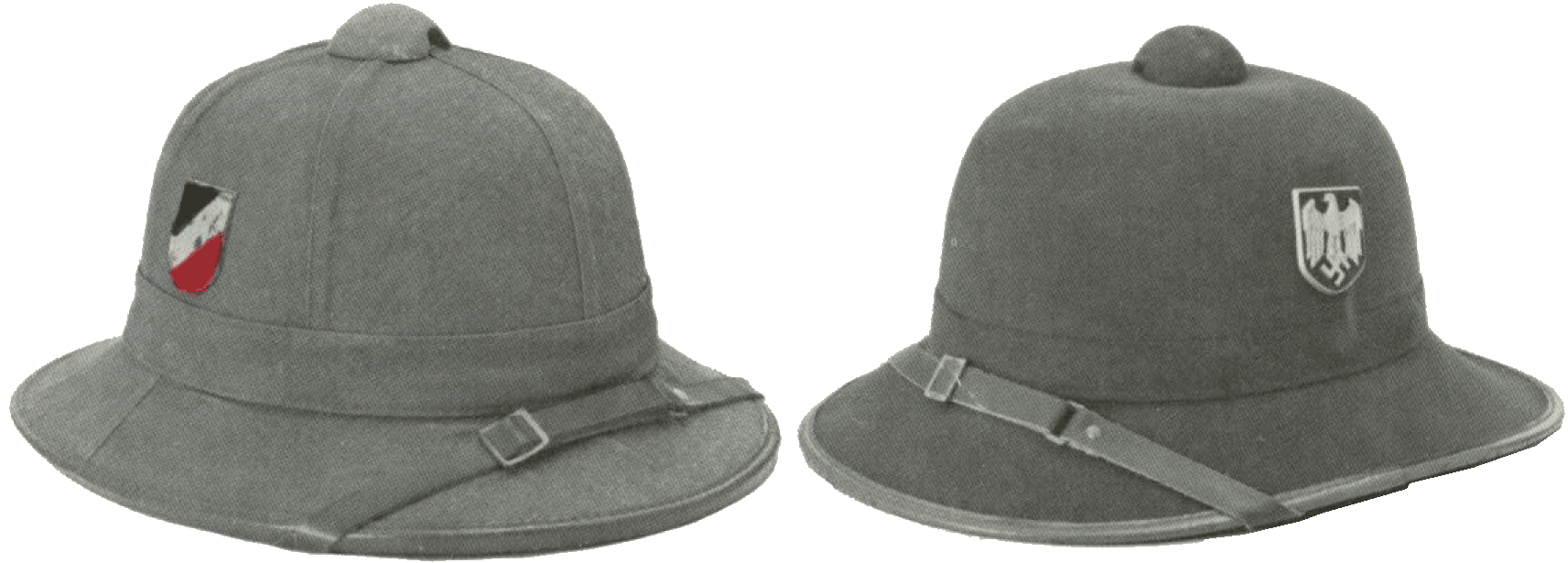
Two different styles of tropical helmet issued to the Afrika Korps: left, of greenish drill fabric over cork, and right, of brown felt. The insignia were in the form of pin-back metal shields. (Author's collection)
A3 Leutnant, Panzertruppen, vehicle parade uniform, 1939
The Sonderbekleidung, or special black vehicle uniform of the Panzertruppen, was issued to all ranks for wear when in the field, or when working or parading actually in their vehicles. The colour was intended partly to conceal oil stains. The short, double-breasted Feldjacke could be buttoned to the throat, giving extra protection from the elements and the sharp projections inside a tank. The long, loose trousers were gathered at the ankle.
The loose black beret, or Schutzmütze, was worn over a rubber skull-protector. Flat woven badges, in white or silver depending on rank, were sewn to the front - the usual eagle surmounting an oak wreath and the Reichskokarde. The shirt was mouse- grey, the tie black. The tunic was piped around the collar in pink. The breast eagle appeared in white or silver, depending on rank. All ranks wore identical collar-patches - an unusual feature. They were black, outlined in pink piping, and bore small silver-grey metal skulls. Rank was indicated only by the shoulder-straps, of conventional design with Waffenbarbe underlay, and on this uniform normally sewn to the shoulder all the way round, to prevent snagging on equipment inside the vehicle. The trousers were gathered at the ankles of the standard knee-length marching boots.
Special features worn by this officer include the heavy silver cord aiguillettes worn by all commissioned ranks on ceremonial parades; the ribbon of the Iron Cross 2nd Class in the tunic buttonhole; and the Four-Year Service Medal. This Leutnant served with the expeditionary tank force in the Spanish Civil War; he wears around the right forearm a red cuff-title with gold edges, bearing on the outside of the arm the words '1936 Spanien 1939'. This was instituted in June 1939. The 1936 version of the Tank Assault Badge, with a large skull motif over a crude representation of a tank within a wreath, is worn in silver on the left breast. The silver brocade belt, with circular silver buckle, was worn by officers on parade occasions.

B1 Unterfeldwebel, Panzertruppen, winter 1939
Until the introduction of special winter combat clothing later in the war, the tank crews had no alternative but to wear the standard Army field-grey greatcoat in cold weather. In the confines of a crowded tank this was a highly impractical garment. This N.C.O.'s rank is indicated by his shoulder-straps, looped and buttoned to the shoulders of the coat. The Schutzmütze is still worn, as are the marching boots. The P.08 pistol was a standard-issue personal weapon for tank crews.
This pattern of greatcoat, with a turn-down collar of dark blue-green badge cloth, was of pre-war issue; as stocks ran down, it was replaced with coats of inferior finish, with plain field-grey collars.

The tropical helmets were often discarded in favour of the practical, comfortable - and stylish - tropical field cap. The eagle insignia are woven in light grey-blue on a tan ground, and the national cockade on a tan patch. (Author's collection)
B2 Gefreiter, Panzer-Pioniere, 1940
Considering the importance, in any armoured formation, of recovering and repairing damaged vehicles swiftly, if necessary under fire, it is not surprising that each Panzer Division included a battalion of armoured combat engineers, or Panzer-Pioniere. This junior N.C.O. belongs to such a unit; his rank is indicated by the single white chevron on the left upper arm of his jacket. He wears the standard black vehicle uniform, but his branch of service is differentiated (by an order of 10 May 1940) by the replacement of pink Waffenfarbe with black and white mixed piping. This appears around his shoulder-straps, the collar of his jacket, the collar patches, and in a chevron on the front of his sidecap. This use of the ordinary field-grey Feldmütze with the black uniform was much seen in 1940 - and even as late as 1943 - owing to the black beret being withdrawn in the winter of 1939/40 before stocks of the new black Feldmütze were generally available. The badges on the cap are the usual small eagle surmounting a national cockade; the breast eagle is white.
B3 Major, Panzertruppen, vehicle uniform, 1941
This company commander wears the usual vehicle uniform, with the twisted silver cord shoulder-straps of his rank. He wears the officer's version of the black Panzer Feldmütze; the crown seam and the front arch of the 'turn-up' are piped in silver, and the national cockade is enclosed by a chevron of pink Waffenfarbe piping. Below the silver breast-eagle is the silver star of the War Order of the German Cross. This decoration was instituted in late summer of 1941, to provide an intermediate decoration for those who already held the Iron Cross 1st Class, but did not qualify for the Knight's Cross. The ribbon of the Iron Cross 2nd Class is worn in the buttonhole, and the Iron Cross 1st Class is pinned below it. Grouped with it are the 1940 Tank Assault Badge - awarded for armoured personnel who took part in three separate actions, on three separate days, while actually in armoured fighting vehicles - and the silver Wound Badge.
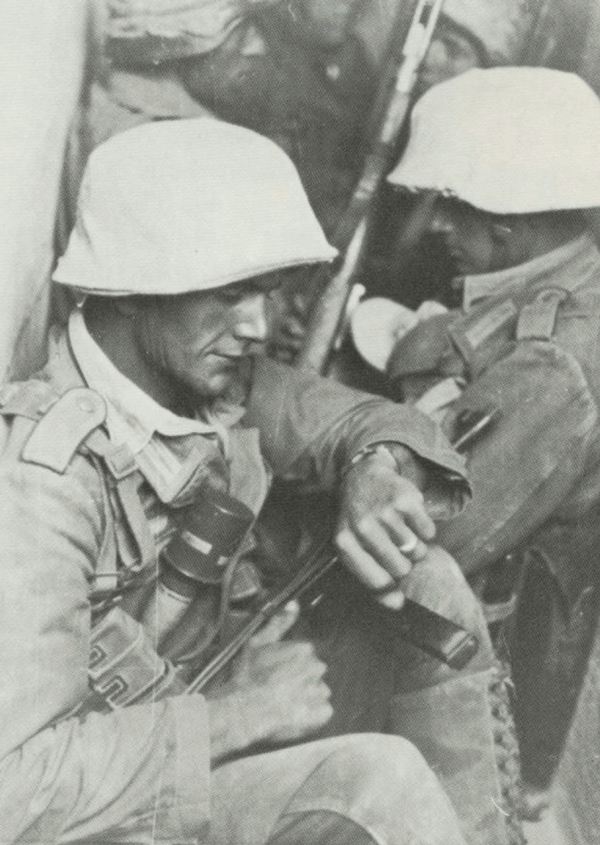
Tired Afrika Korps soldiers display several interesting details of kit; note the high-lacing canvas boots, the light-coloured hessian helmet covers, the pouches for the MP. 40, and the thin drill uniforms. (Imperial War Museum)
The plain, double-claw buckled belt was the usual field wear for officers. The earphones and throat microphones are worn even when the soldier leaves the vehicle for a time - it is simpler to pull out the jack-plugs than to remove the hampering cables and then replace them, in the confines of a turret. The boots are now lace-up ankle-length items in many cases, although the old marching boot would continue to be worn for another two years or so, alongside the newer style.
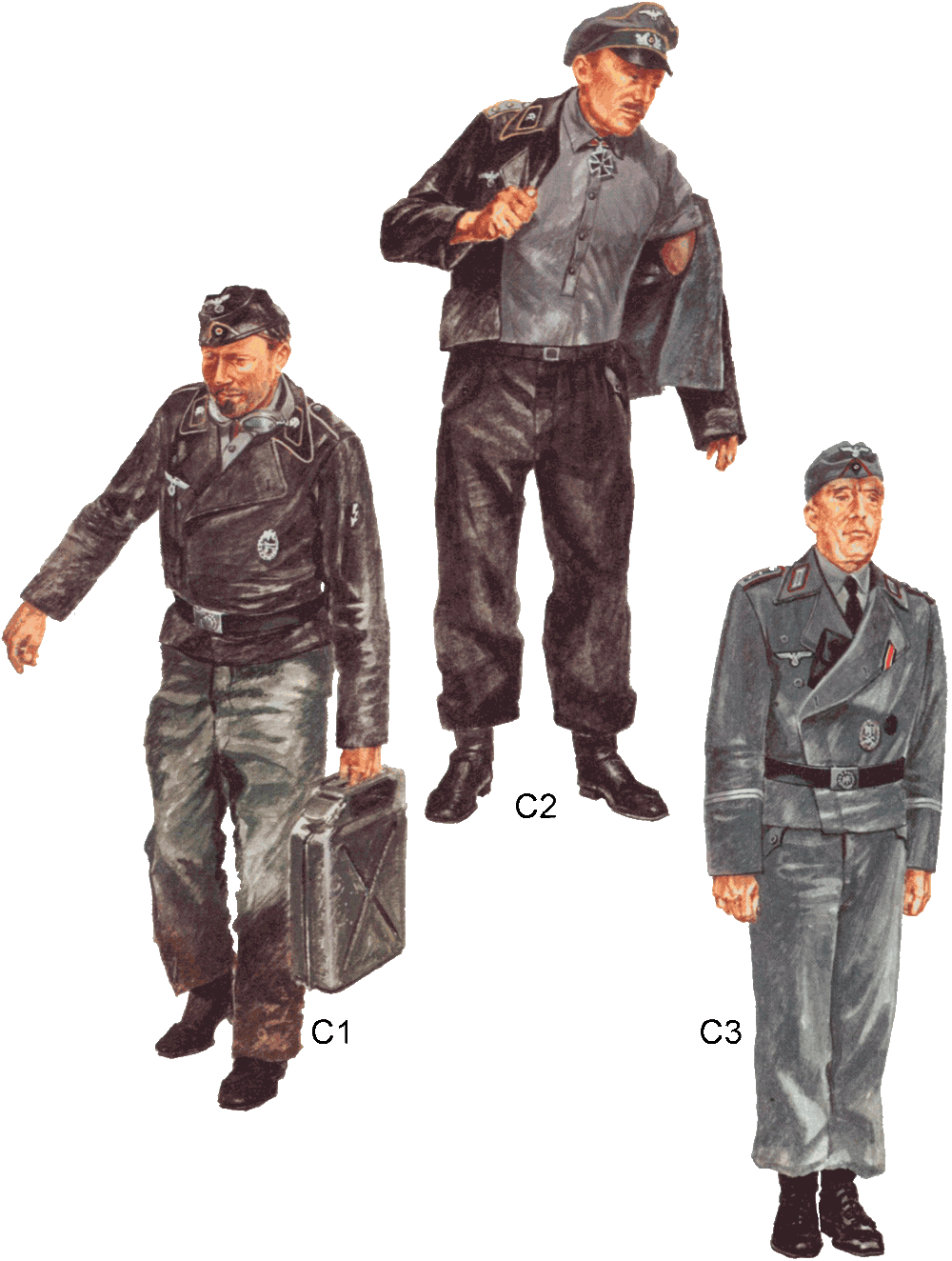
C1 Panzer-Funker, campaign dress, 1941
A tank radio operator, as he might appear during the great advance into Russia in the summer of 1941. Not only the tanks wore out - the men themselves became exhausted, and had no time to spend on their appearance. This private wears the black Feldmütze of the enlisted personnel and N.C.O.s, without silver piping. His jacket is unremarkable, except for the small white lightning- bolt badge on the left upper arm, identifying his trade. He wears a common combination of garments for the long weeks of constant living and working in a front-line tank; his uniform jacket belted over an old pair of working over-trousers, which hang loosely to the ground. The pink collar piping began to be omitted from the Feldjacke from mid-1942 onwards, but old stocks were used up.
C2 Hauptmann, 24. Panzer Division, 1943
This captain wears the standard vehicle uniform, with one interesting variation. In recognition of the fact that it was raised from the elite 1st Cavalry Division (the only Panzer formation raised from the cavalry arm) the 24th Panzer Division had the distinction of wearing golden-yellow cavalry Waffenfarbe piping in place of the usual rose-pink. It appeared at all points on the uniform and headgear normally distinguished by pink piping.
This officer displays a common practice: with his black uniform he wears the soft-peaked, rather battered-looking 'officer's old-style field cap' (Offizierfeldmütze älterer Art), without any cords or chinstrap, and with flat woven badges in silver on dark-green grounds. It is piped in cavalry yellow, in identification of his unit. Under his tunic he wears the usual pocketless mouse-grey shirt (Heeres Hemd); as a Ritterkreuzträger, he wears his Knight's Cross on its ribbon passing beneath the shirt collar.
We have much more interesting information on this site.
Click MENU to check it out!
∎ cartalana.com© 2009-2025 ∎ mailto: cartalana@cartalana.com